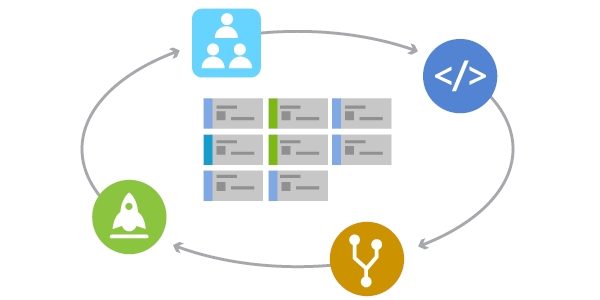Agile Development

Agile is a term that describes approaches to software development that emphasize incremental delivery, team collaboration, continual planning, and continual learning. The term Agile was coined in 2001 in the Agile Manifesto. The manifesto set out to establish principles to guide a better approach to software development. At its core, the manifesto declares four value statements that represent the foundation of the Agile movement. As written, the manifesto states:
We have come to value:
Individuals and interactions over processes and tools.
Working software over comprehensive documentation.
Customer collaboration over contract negotiation.
Responding to change over following a plan.
The manifesto doesn't imply that the items on the right side of these statements aren't important or needed. Rather, items on the left are simply more valued.
Agile in Modern DevOps
In today's cloud-native world, Agile methodologies have evolved to integrate with DevOps practices, creating a seamless pipeline from development to production. This integration enables:
Rapid iteration cycles: Code changes can flow from development to production in hours rather than weeks
Continuous feedback loops: Telemetry and monitoring provide real-time insights into application performance
Infrastructure as Code (IaC): Treating infrastructure provisioning as part of the development process
Shift left on security: Embedding security testing and validation early in the development lifecycle
Common Agile Frameworks
Scrum
Scrum is the most widely adopted Agile framework that organizes work into time-boxed iterations called Sprints (typically 2-4 weeks).
Key components:
Product Backlog: Prioritized list of features and requirements
Sprint Planning: Team selects items from backlog to complete during sprint
Daily Standup: Brief synchronization meeting (15 minutes)
Sprint Review: Demonstration of completed work
Sprint Retrospective: Team reflection on process improvement
Kanban
Kanban focuses on visualizing work and limiting work in progress (WIP) to optimize flow.
Key components:
Kanban Board: Visual representation of work items in columns (To Do, In Progress, Done)
WIP Limits: Restrictions on how many items can be in progress simultaneously
Flow Metrics: Measuring lead time, cycle time, and throughput
Scaled Agile Frameworks
For larger organizations, scaled frameworks provide structure for multiple teams:
SAFe (Scaled Agile Framework): Enterprise-scale framework for coordinating multiple teams
LeSS (Large-Scale Scrum): Extends Scrum principles to multiple teams
Spotify Model: Team-based structure with Squads, Tribes, Chapters, and Guilds
DevOps Integration with Agile
Modern Agile teams leverage DevOps practices to accelerate delivery and improve quality:
Continuous Integration (CI)
Continuous Delivery/Deployment (CD)
Infrastructure as Code (IaC)
Agile teams manage infrastructure with the same version control and testing rigor as application code:
Implementing Agile in Your Organization
Getting Started
Start small: Begin with a single team and expand practices gradually
Focus on automation: Invest in CI/CD pipelines early to eliminate manual steps
Build cross-functional teams: Include operations, security, and testing expertise
Embrace iterative improvement: Use retrospectives to continuously refine processes
Key Performance Indicators (KPIs)
Measure your Agile DevOps effectiveness with:
Lead Time: Time from idea to production
Deployment Frequency: How often code is deployed to production
Mean Time to Recovery (MTTR): Time to recover from failures
Change Failure Rate: Percentage of changes that result in incidents
Agile Tools Ecosystem
Modern Agile implementations leverage numerous tools:
Project Management
Jira, Azure DevOps, Monday, Asana
Source Control
GitHub, GitLab, Bitbucket, Azure Repos
CI/CD
Jenkins, GitHub Actions, GitLab CI/CD, Azure Pipelines
Infrastructure
Terraform, Pulumi, AWS CloudFormation, Azure ARM
Monitoring
Prometheus, Grafana, Datadog, New Relic
Collaboration
Slack, Microsoft Teams, Miro, Confluence
LLM Integration in Agile Workflows
Large Language Models (LLMs) are enhancing Agile practices through:
Automated Code Reviews: LLMs can assist in reviewing pull requests and suggesting improvements
Documentation Generation: Auto-generating technical documentation from code
User Story Refinement: Analyzing and enhancing user stories for clarity and completeness
Test Case Generation: Creating test cases based on feature requirements
Example: GitHub Copilot in Agile Development
Case Studies
Spotify's Agile Engineering Culture
Spotify's approach focuses on autonomy with alignment:
Teams (Squads) are autonomous but aligned to company goals
Communities of practice (Chapters) ensure technical excellence
Tribes coordinate related Squads working in the same business area
Netflix's Chaos Engineering
Netflix employs deliberate system testing in production as part of their Agile approach:
Chaos Monkey: Randomly terminates instances to ensure resilience
Integration of failure testing into the development process
Culture of freedom and responsibility aligned with Agile values
Resources
Last updated